Chapter 6 – Reproduction: Weird Mating Rituals
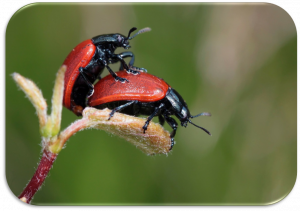
In Chapters 2-5, we took a comprehensive look at insect and human anatomy and physiology. One of the take home messages is that both humans and insects encounter similar problems to solve in trying to earn a living on the planet earth. Both insects and humans have to breathe and circulate oxygen and nutrients throughout their bodies(Chapter 2). Both types of organisms have to find food, process it, and extract nutrients from it (Chapter 3). Both have to grow, develop, and change over their lifetimes (Chapter 4). Both must sense and respond to external and internal changes in their environments (Chapter 5). And both have to find mates and reproduce, which we will explore further in this chapter.
We also learned that even though insect and human needs are at least superficially similar, both types of organisms have physiological systems (i.e. respiratory, circulatory, digestive, excretory, endocrine, and nervous systems) that solve the problems of existence in somewhat different ways. And you also learned how different anatomical structures support different physiological processes in achieving ostensibly similar ends. We certainly have covered a lot in just a few chapters, and it takes a while to assimilate that much information. So, during this chapter, we hope to aid you in that process and also increase your understanding of insect and human systems by looking at one issue—reproduction—in a little more depth than was possible in our global, panoramic view in previous chapters.
Insects have proven to be at their height of creativity in figuring out how to find a mate, conduct mating rituals, and produce offspring. Insect reproduction is a thing of wonder that can teach even Casanova, Don Juan, and Dr. Phil a thing or two about how it is done in the real world. This is perhaps the most fun chapter because some of the lengths insects have gone to in order to reproduce are just, well, unbelievable. First, we will briefly explore the similarities and differences between the human and insect male reproductive systems. Then we will address the issue of simply finding a mate. That will bring us to a discussion of courtship, or how males and females are persuaded to engage in the act of mating. Again, there are remarkable similarities between humans and insects despite the gulf of evolution by which they are separated.
Next up, we will look at the processes by which mating or copulation occurs. You’ve been programmed by movies and books, and perhaps your own imagination, to believe that humans are ingenious when it comes to this issue. But we think you will find that insects have thought of things that even filmmaker Wes Craven never entertained. We’re not telling you about these things because we think they are good ideas worthy of emulation by humans. Indeed, many of them would be illegal even under today’s liberal standards. But they do nicely illustrate that nature thrives on diversity and, having so many different species of insects, it’s inevitable that some of them will try anything even if some of it seems counterproductive to mere mortals like us.
This will bring us to the question of the various ways in which insects can produce offspring. Here you will find that humans (and all other mammals) are very boring in comparison to insects: for us to create offspring, we require the union of sperm produced by adult males with an egg produced by an adult female. Although this is generally true for insects, there are some fascinating exceptions. This leads logically to a discussion of how the offspring are delivered, which has many tie-ins to the question of mating systems. Again, you will see that insects are way more adventurous than humans.
Finally, we will take a look at how insects care for their young. As you can imagine, there are some differences between humans, who typically produce one child and a time, and insects that may produce thousands in a single mating event. But even with this proviso, there are some insect stories that are both heartwarming and amazing, and others that are terrifying. So, with that as introduction, let’s get started!
Insect and Human Reproductive Systems
In contrast to many of the other physiological systems that we have compared between insects and humans, the human and insect reproductive anatomy are really pretty similar. In both cases, there are organs located in the vicinity of the urogenital tract whose job it is to produce gametes (Figure 6.1a, b) and, when the time for reproduction comes, get those gametes together so that the new generation can be formed. In a sense, you already know the basics. Again, you will find that insects and humans have similar needs they have solved using remarkably similar approaches.


Yes, a simple gander at the diagrams in Figures 6.1a and 6.1b affirms the basic similarities in the structures of the relevant reproductive organs in insects in humans. For example, both male insects and male humans have testes that produce sperm. Moreover, both male insects and humans produce additional fluids that help to package and protect the sperm, and may contain other components that can help change the behavior and physiology of the female. In insects, these components are produced largely by the accessory glands, whereas in humans they are produced by the testes. In both male humans and insects, sperm and their associated fluids travel down the seminal vesicle/duct and are released through the ejaculatory duct.
Before we move on, we would like to note that the female reproductive systems are also highly similar. However in the interest of keeping this chapter short and sweet, we only present the male reproductive systems here.
Finding a Mate
Since no sexually reproductive organism can reproduce until it has found a member of the opposite sex, let’s now consider the problem of finding a mate. In contrast to insects, humans have this pretty easy. We are social animals, so we like to hang out in places where we will find other people. We go to school, to work, to shopping malls, and to parties. Bars are also a very common place to find people and, of course, you have the added inducement of alcohol there to help overcome inhibitions and make the whole dating thing easier. These are all time-tested ways of meeting someone of the opposite or same sex with whom you might be interested in dating or even producing offspring. And it’s easy for us to recognize fellow humans from other species, making it easy to identify our potential dating pool. Plus, if you’re a human, you have even more assistance with finding a partner in the proliferation of dating websites that promise to sort through all of the available choices and find you the one.
However, insects face a fairly formidable set of problems. In order to successfully reproduce, they have to find a member of the opposite sex from the same species, called conspecifics, which can be difficult when there are other highly similar-looking species around. Closely-related species may be able to form viable hybrid offspring (i.e. able to survive), but it is unlikely that the hybrids will be fertile (i.e. capable of giving the insect progenitor grandchildren), so it is an evolutionary dead end. If you’re a beetle, for instance, there are probably lots of other beetles out there somewhere—but how do you get conspecifics together among the many, many species of beetles present in each locality? Insects are fairly small and may or may not have the means to travel. Even if they can travel, they are not going to go very far—at least compared to humans. Geography is, thus, something that limits an insect’s ability to find a mate. A second problem is distinguishing a mate from among a whole bunch of insect species that all look similar. Most insects do have eyes but, as we discussed in Chapter 5, their ability to resolve and focus images is limited and, hence, most are not able to visually pick out members of the same species from among many related species. Another difficulty that many insects encounter is that numerous species mate only at night when it is hard to see anyway. Considering all of these challenges, you can now easily understand why finding a conspecific mate is anything but simple for an insect.
Figure 6.2a (click on link) nicely illustrates one of the challenges of finding a mate in insects. All of the insects in this picture are common fireflies in North America—you know, the critters that you used to catch on summer evenings as a kid and put in jars so that you could see them light up at night? They all look about the same, and even experienced entomologists have trouble telling them apart. And yet, each of them is a different species. None of these fireflies would be able to produce fertile offspring if they mated with each other. So to more easily distinguish their own species from one another, they have developed a rather creative solution: the males of each species produces unique flash patterns that are easy to tell apart (Figure 6.2b – click on link). Therefore, a female waiting nearby can clearly tell when a male of her species is “calling” out, and can respond with her own unique flash pattern. However, this system is not without its disadvantages. The females of one particular genus of firefly, Photuris, are fearsome predators and will mimic the flash pattern of females in the genus Photinus. So the poor male Photinus firefly sends out a light flash and sees the correct flashing in return, from what he thinks is his dream girl. He then flies in, ready to mate, but instead is attacked and eaten by the larger Photuris female.
Other insects have ingeniously solved the problem of how to get together with others of the same species in several ways. But one of the most widely used is the production of pheromones. Pheromones are small volatile chemicals that are usually produced and released by the female in order to attract a male of the same species. Because the pheromones are volatile they will enter the gaseous phase and travel on air waves, thus allowing the chemicals to be distributed over a large geographic area. Conspecific males have receptors that are specific to the pheromones produced by females of their species. Once the pheromone binds to the target receptors, usually located in the male’s antennae, it activates search behavior of the male in a quest to find the female that is releasing the pheromone.
Interestingly, closely related insects like the different species of fireflies you saw in Figure 6.2 may use similar pheromones, but with enough structural differences to be specific. Or related species may use a mixture of two identical chemicals, but each species will use a different quantitative mixture of the chemicals. For instance, Species A, might use chemicals X and Y in its pheromone mixture in a 1:1 ratio, while a related species might use the same two chemicals but in a 2:1 ratio. Therefore, the specificity of pheromones and/or their mixtures ensures that only conspecifics are attracted to one another.
Using pheromones, conspecific males and females can be attracted to the same geographic location, but there are still some impediments to successful mating. Just like in humans, you have to have mechanisms for finding the best potential mate. And once you settle on an individual, a little persuasion may still be required—especially if the objective is not just sex but reproduction. And here humans and insects show remarkable similarities.
Mate Selection and Courtship
If we start the discussion with humans, we could come up with a very long list of desirable criteria for a mate, and undoubtedly, the list would vary among each of you. But, we can summarize by noting a few things: people are attracted to each other as a result of specific physical (e.g. height, eye color, etc.) and behavioral (e.g. ability to sing and dance) characteristics. A second major criterion is the kind of resources you are able to bring to the table. It is certainly true that people who have a lot of resources, like money, property, and power, are viewed as highly attractive by a large portion of society. And then there are the somewhat ineffable characteristics, like a “sense of humor” or being “sensitive,” that people look for in a mate. For example, it is alleged that heterosexual women like a man who is willing not just to have sex but to engage in conversation and show tenderness through cuddling and other nonsexual activities. Humans also prefer mates that smell good. Do insects show these same preferences?
Believe it or not, yes they do. Insects do engage in what biologists call sexual selection, a special case of natural selection where members of one sex more frequently mate with members of the opposite sex that have desirable characteristics, thereby increasing that trait in the population over time. For example, male insects generally prefer to mate with larger females compared to smaller ones, likely because larger females are capable of producing more eggs. More commonly though among species where sexual selection occurs, females are believed to be the more selective or choosey sex, because they invest more energy into egg production and parental care. And, much like in humans, why a female selects one male over another is largely a mystery to the outside observer. But there is evidence that female insects and other arthropods do favor males that can sing, dance, and cuddle as well as those that will provide a home or at least a nutritious gift to help her produce more offspring.
Arthropod Singers, Dancers, and Cuddlers
There certainly are insects that attract a mate by singing. Usually it is the job of the male to produce the sound, and it is easily perceived by humans when, for instance, crickets or cicadas sing to attract a mate. In fact, the mating activity of these insects is often highly irritating to humans because it can be very loud and persistent, and often takes place at night when we’re trying to sleep. One might also consider this a sort of auditory pheromone since each species produces a unique song or pattern of vocalization that is designed to bring males and females into proximity of one another. Mosquitoes push this to a whole new level by having male and female engage in a romantic duet by flying off together and adjusting the frequency of their wing beats. Again, mosquito mating often occurs at night, but generally away from humans and either before or after the female has taken some of your blood.
Furthermore, some arthropods have serious rhythm and are pretty good dancers. One example of this is the peacock jumping spider who does a pretty good cha-cha. The male will do some brilliant and charming dance moves that include drumming on the substrate and crazy energetic zig zag moves to impress his intended (Video 6.1). Unfortunately, in this example, she does not appear to be receptive to his advances. Hopefully he has better luck on his next attempt!
For springtails, wingless 6-legged arthropods that are very closely-related to insects, the male will not be successful in mating unless and until he pampers her a little. He conducts a complicated mating ritual that initially involves a sort of advance and retreat, push and pull arrangement (Video 6.2). If the female appears to be receptive, he will rub her with his antennae and if she responds, he will have a pretty good night. This is an example of cuddling behavior among insects. Having played the “I can be tender” role, the male will then deposit a spermatophore (package of sperm) directly in front of the female, as if anything less than making the female trip over the sperm package will be insufficient to get the idea across. The male may also continue his tender ministrations to the female in order to get her to walk over to the spermatophore if she still isn’t getting the idea. If she is in a mood to bear young, she will pick up the spermatophore and insert it into her gonopore (genital opening) so that the sperm can find their way to the eggs. If all goes well, she will produce fertilized eggs. If not, she may just eat the spermatophore. In fact, this happens 29% of the time. Oh well.
Providing Resources and Gifts
Many insects definitely choose a mate based on their perceived ability to provide resources and support potential offspring. Once again, it is generally the males that do the work in providing resources as a means to attract females. For example, even though in some species of dung beetles, both males and females roll balls of dung (animal excrement) as a food source and nutritive place to deposit eggs, generally it is the males that do the lion’s share of the work (Figure 6.3). Male dung beetles invest quite a lot of time and energy into rolling an exquisite ball of dung to attract a female. Nothing says “I truly love you” quite like a big ball of dung! In some species, the mated pair actually rolls dung balls together, which we are sure is a romantic gesture. After finding the perfect location for their love ball, the pair will mate and the female dung beetle will deposit her eggs in the ball of dung. Then the male and female work together to bury the egg-infested ball of poop. Thus, after the eggs hatch, the baby dung beetle larvae not only find themselves somewhat protected from the hot external environments, but also provisioned with a delicious first meal. Therefore, male dung beetles rolling poop around are not just attractive to the females; they are also excellent fathers.
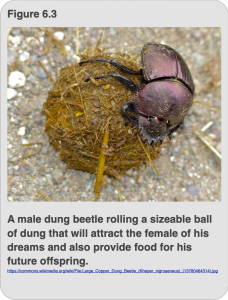
There are many ways to demonstrate resource abundance among insects, but certainly the most charming is the so-called nuptial gift. This is a gift that the male will present to the female as an inducement to mate. Many females are very discerning and will carefully inspect the gift to make sure that it is up to her standards. A high-quality gift indicates that the male is physically fit, likely to produce good offspring, and can assist in resource acquisition. There are several possible types of gifts and they vary among species. The purpose, as previously mentioned, is to provide an incentive to get the female to mate. But nuptial gifts may also offer a way to nourish the female, thereby increasing her chances of producing a successful brood. Furthermore, in some predatory species where the female may be larger than the male, it is a mechanism to distract the female from doing harm to the male during the act of mating. Really, it can be quite violent!
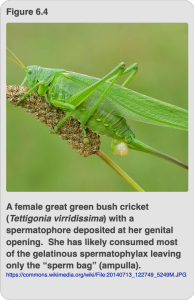
Some species, such as the bush cricket, produce a spermatophore that contains a large, bulbous spermatophylax. This is a gelatinous substance produced by the male and presented to the female (Figure 6.4), and is ingested by the female if she accepts him. Originally, the spermatophylax was thought to nourish the female and assist in producing eggs. However, recent studies indicate that the nutritional composition of the spermatophylax is quite low, the equivalent of flavored chewing gum, and has chemicals in it that induce the females to feed. And the longer she feeds on the spermatophylax, the more sperm is transferred into her genital tract. This particular nuptial gift also has the additional benefit that it imposes a physical barrier that keeps other males from accessing the female’s genital opening. Win-win!
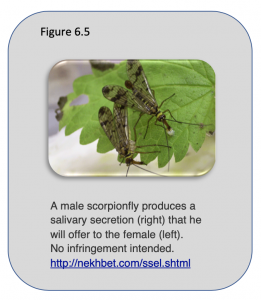
Scorpionflies have a particularly interesting method of using a spermatophylax. The male will hack up a salivary secretion and, dripping with spit, offer it to his beloved (Figure 6.5). This is a nutritious gift and helps to prepare the female to produce lots of eggs. The female scorpionfly consents to sex only if she gets a present up front, and male scorpionflies will collect any spermatophylax not consumed by the first female and proudly present it to his next potential partner—kind of like getting a used, half eaten box of candy as a present. How abominable!
A fairly common kind of nuptial gift is for the male to offer the female some sort of dead insect to eat. Some scorpionflies do this instead of producing a salivary secretion, and many other insects do it as well, including dance flies (Figure 6.6). Although some male scorpionflies are absolutely above-board and earnest about the gift, other scorpionflies try to get by without doing too much work—instead of catching the insect gift himself, he simply steals an insect caught in a spider web.
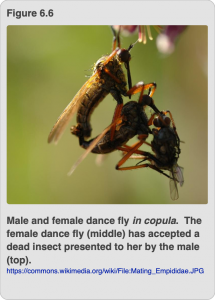
Others insects, like the balloon fly will thoughtfully wrap his dead insect present in a silk balloon (hence the name) prior to presenting it to his lady friend. Wrapping in silk may serve two purposes: first, it is harder to eat the dead insect if it is wrapped, so the female can’t just eat the present and run. Second, unwrapping the gift distracts the female and allows the male to mate with her longer and transfer more sperm. Males in a related but more enterprising species produce a silk balloon to attract the female, but it has no actual insect present in it! Clearly, some insects are just as devious as some humans when it comes to the mating game.
Smelling Good to the Opposite Sex
Humans, especially those in the United States, spend a lot of time washing ourselves with soaps and covering our bodies with perfumes, body sprays, and colognes that we hope will smell good and be attractive to potential mates. Not surprisingly, male insects often do the same thing. But instead of obtaining their scents from alternative sources, male insects produce their own aphrodisiacs—chemicals designed to increase sexual attractiveness and lure in members of the opposite sex. Males of the queen butterfly, for instance, have hairs on their abdomen that produce an aphrodisiac to attract females. If she draws near him, he will dust her abdomen with the aphrodisiac to increase her willingness to mate. Adult male mealworm beetles go one step further by dousing their mated female partner with an anti-aphrodisiac to make her less attractive to other males and increase the chances that she will not mate with others and will bear only his offspring.
Doing the Deed: Copulation
We now come to the fascinating issue of the act of mating or copulation. In humans, you know the details. It’s pretty simple if the goal is to reproduce. Since you’ve had years of sex-ed, we do not need to elaborate. If the goal is not reproduction, but sex, humans do like a little variety and will have sex just about anywhere, in many positions, and using several different orifices. Again, we doubt that we need to elaborate. But what about insects? Here, the options would seem to be rather limited but, alas, they are not. In fact, are so numerous that we cannot address them all here, but we will detail a few just to give you a taste of the incredible variability and creativity insects invest in mating.
As we previously mentioned, sexual selection, or preferential mating, definitely occurs in insects and it is generally considered that females are the more choosey sex. However, we must first acknowledge that both sexes make significant contributions to the act of mating and, although we sometimes deride the male contribution as insignificant (both in humans and insects), nothing could be further from the truth. We previously saw the great lengths that male insects will go to in order to find a female (such as by flashing lights in the case of fireflies or following a female’s pheromone plume in moths). We also saw how male insects and other arthropods sing, dance, and provide resources to seduce females.
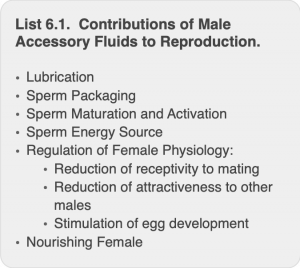
And when it comes to copulation, males also make a significant contribution. As you can see from List 6.1, there are a variety of products that the male makes and packages, along with sperm, and the effects of these additions are very important: they help propel and nourish sperm en route to the eggs they will fertilize. They are also important in nourishing the female and/or her eggs and providing hormonal stimulation to support fertilization. And in insects, the male ejaculate even provides hormones that invoke behaviors that will assist in brood production.
External and Internal Fertilization in Insects and Humans
In human reproduction, if you want to produce a child by typical means, it is necessary for the male to release millions of sperm into the female urogenital tract in hopes that one sperm will be successful in traveling to the egg and fertilizing it. The event usually takes place in the fallopian tubes of the female and the fertilized egg then continues its journey into her uterus where it will embed in the uterine lining and establish a pregnancy. So both fertilization and pregnancy are internal events in humans. he only exception occurs when a pregnancy is produced by artificially inseminating an egg outside the woman’s body, so-called in vitro fertilization, and then implanting the fertilized egg in her uterus.
Among insects and other arthropods, however, fertilization does not necessarily take place in the female’s urogenital track. In some species, including spiders and the primitive springtails we considered earlier, the male will deposit a spermatophore (package of sperm) somewhere in the environment and the female of the species will pick it up an insert it into her reproductive system. This so-called external fertilization is considered a primitive form of reproduction in insects because it does little to ensure that the sperm and the egg will get together, and the male of the species can never be sure that the eggs the female has laid were fertilized with his sperm.
Internal fertilization, such as what happens in humans, is considered an advanced trait and is found in most insects. In this case the insect male intromittent organ is called the aedeagus rather than the penis, but the idea is the same as in humans. Upon successfully finding and courting a female, a male insect inserts his aedeagus into the female reproductive tract (called the bursa copulatrix) and deposits sperm. The fate of the internally released sperm can vary, however. Sometimes it works as it would in humans—that is, the sperm swim along until they find eggs to fertilize. However, most female insects have an internal storage pouch called a spermatheca in which she will store the sperm, only releasing them to fertilize her eggs when she thinks conditions are optimal.
Alternative Mating Organs
At this point, it is fun to acknowledge that some insects have decided that the usual sex roles and sex organs are not for them. Here, we have the example of cave-dwelling barklice in the genus Neotrogla. In this case, the female has the intromittent organ, or penis-equivalent, and the male has a simple genital chamber in which the sperm are harbored. The female intromittent organ, called a gynosome, is very elaborate and is adorned with many spines and pouches. At mating time, she will insert her gynosome into the male pouch where he will pass a highly nutritious ejaculate into the gynosome. In these insects, the act of mating is prolonged, taking between 40-70 hours! This makes it possible for the male to transfer large quantities of nutritious fluids that help maintain the sperm and promote the fertilization process. Pretty amazing!
Mating in Flight
Some humans think they are sexual acrobats and are fond of finding new places to practice their art. But really, they have absolutely nothing on insects. The only way humans can have sex in flight is to ignominiously use the bathroom of an airplane which lacks both space and anything approaching panache. But, some insects can literally have sex on the wing and in a variety of interesting positions.
Let’s take dragonflies and damselflies as examples. While in flight, a male dragonfly will grab the female’s thorax with his legs and continue flying while attached. The male can be a bit brutish and may bite the female to subdue her if she resists. Successful mating requires that the male get a better grip on the situation and also bring his genitalia in proximity to hers which grasping the thorax won’t provide. So, in an effort to mate successfully, the male will pull his abdomen forward and grab the female around the neck with a pair of appendages called cerci that are situated at the anal end of the male. This gives him a better grip and he will continue to fly with her in tandem (Figure 6.7).
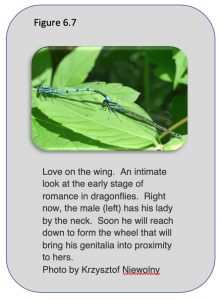
When they get to the sperm transfer part, dragonflies do some really interesting gymnastics. First, in some species, the male will clean out the female’s genital track with the intention of removing the sperm of any other male the female had previously mated with. Using backwards-facing hooks on his aedeagus, the male will scrape out any sperm left by a previous mate. Once it is clean, his sperm will be the only source of fertilization. Then, to affect the actual transfer of sperm, the insects have another problem to solve. There is an anatomical mismatch between the respective placement of the relevant body parts of the two sexes. The female genital opening is at the end of her abdomen but the relevant parts of the male are located much closer to his thorax. In order to transfer sperm, the female has to bring the tip of her abdomen close to his thorax where his aedeagus is located. Just a quick side note here: dragonflies actually have secondary sex organs, which means that sperm is produced and released elsewhere on his body, and must be transferred to his aedeagus before copulation. But once this is done, he is ready to transfer it to the female. In order to accomplish this, the dragonflies bend into a circular arrangement called the “wheel formation” because of its shape, although it also can resemble a sideways heart. As you can see from Figure 6.8, this is a pretty awkward formation to keep airborne, so some species find a place to alight and transfer sperm. Others keep the mating-in-flight thing going, making them the true artists of aerial sex.
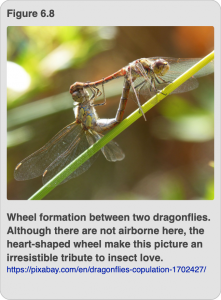
But the mating competition among dragonflies doesn’t stop there. There is another whole level of male competitiveness, of which humans are only nominal practitioners. Dragonflies are highly evolved in the art of sperm competition, and the foundational principle is that the last sperm in are the ones to fertilize. So the males have a variety of adaptations to make sure that their sperm is the last entry into the female genital tract. We’ve already mentioned how some dragonflies use the aedeagus to scrape any sperm from a previous male out of the female’s urogenital track. But that is just the beginning. Other dragonflies don’t scrape out foreign sperm but they do their best to beat them into submission by forcing the previous males’ sperm to move aside in order to give the new male direct access to the female’s eggs. Others believe that dilution is the solution to the problem—they will simply inundate the female with sperm so that the eggs the new male fertilizes will be more numerous. Other mechanisms include refusing to release his grip on the female until she has laid eggs (or at least engaged in oviposition behaviors) and chasing any other males away until he sees that the female that he has just mated with has laid his eggs. Talk about jealousy and intrigue!
Mating Pains
And now we’ve come to the R-rated part of the presentation on mating. We know that humans have some kinky practices, but for the most part, these practices are not meant to facilitate reproduction. In fact, far from it. So we can safely skip what humans do in this area and move on to insects, which have perfected some reproductive practices that would be illegal if humans took them up. And nothing screams out kinky like the bed bug.
As you probably know, bed bugs are a big deal because they are re-surging as a pest. They were once thought be obsolete, but they are back with a vengeance. People hate them because they live in your house and come out to suck your blood while you’re asleep. And they have the interesting property of being thigmotaxic, which means that they like to hide in places where they are closely surrounded by protection, such as behind picture frames or in cracks in the wall. But, when you’re asleep, they will jet out of their hiding place, hit you up for a blood meal, and then go rapidly back into hiding. You will find evidence of their visit in the morning, but you probably won’t see them because they hide pretty well. You’ll also have some super-itchy bumps where they’ve bitten you. Unfortunately, they are notoriously difficult to control because of these thigmotaxic living habits.
Now for their mating exploits . . . but just for the record, female bed bugs have a normal reproductive tract, just like most other insects. However, they don’t use it for mating. Wait, what? Oh no, we’re not kidding: the male bed bugs came up with another super-kinky idea. Instead of inserting the aedeagus into the female reproductive tract, they tear a hole in the female’s abdomen and deposit the sperm wherever the hole is (Figure 6.9). The sperm do eventually migrate around to where the female’s reproductive organs are and fertilize the eggs. Because this kind of copulation involves violently ripping a hole in the abdomen where none previously existed, it is called traumatic insemination, which we think you well agree is a pretty good description. But the weirdness doesn’t stop there.
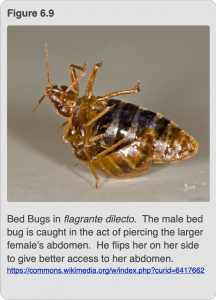
Given how violent copulation is in bed bugs, you might assume that the females would do it only once, and die as a result of having a big hole ripped in their abdomens. But that is generally not true. Many females do survive the experience and will go on to mate again and again. And if you find one of these females, they will show multiple insemination scars on their abdominal walls. Also, the females produce their own antibiotics internally. This has two functions: first, it kills pathogens that enter the female bed bugs when their abdomens are torn open; and second, it is probably the reason that bed bugs don’t transmit human pathogens—they are killed by the antibiotics. Another weird thing is that the females of some species have developed structures to minimize the damage of being traumatically inseminated. On the outside of their abdomens, there is a structure called the ectospermalage, which is basically a sign to the male to tear into her there. Inside of the ectospermalage is another structure called the spermalage, which basically holds the sperm. It keeps the sperm from wandering all over and helps direct them to the female reproductive tissues. And, assuming successful fertilization of the eggs, here’s another weird thing: the eggs are born the normal way insects do it. That is, the eggs move from the female reproductive tract to the outside world with the help of a tube called the ovipositor, which is found in most female insects.
This, of course, begs the question: if the fertilized eggs get out the normal way, why doesn’t the sperm get in the normal way? And, why on earth did bed bugs opt for so barbaric a method as traumatic insemination? Once again, it may be an issue of sperm competition. The females of some species use a plug to prevent the sperm of other males from entering their reproductive tract after they have successfully mated with one male. Traumatic insemination may be a device for subsequent males to have a chance of fertilizing eggs. Other scientists have suggested that traumatic insemination may reduce the resistance of females to mating. If you have a gaping hole in your abdomen, you’re more likely to be focused on that rather than what the male is currently doing, i.e., transferring sperm. And finally, still others have suggested that using traumatic insemination allows the male to deposit his sperm closer to where the eggs are… but that seems a little far-fetched to us since using the female reproductive tract in the usual way would seem to solve that problem. Anyway, bed bugs stand out as the exemplar of weird mating habits.
And here’s one more example of weird mating rituals, but this time, the table is turned—in this situation it’s the male of the species having a terribly painful experience. In fact, it is an example of sexual suicide for the male. What we are talking about are honey bees. And other than pay the ultimate price for a “quickie”, male honey bees (drones) do nothing to help their worker sisters around the hive. In fact, their sole function in life is to inseminate a queen bee.
When she’s ready to mate, a virgin queen, who is normally sedentary and hive-bound, will leave the hive on a mating flight in search of drones. To facilitate this, she releases a sex pheromone that attracts nearby drones who will compete for the chance to mate with her. Eventually, one will be successful in finding and mating with the queen; a feat that requires a fair amount of skill since it takes place in flight. This actually happens multiple times since the queen can mate with over a dozen drones during the course of her flight. All the sperm she acquires is stored in her spermatheca, the specialized sperm storage organs we mentioned earlier. Indeed, the sperm she receives from her mating flight will last for her entire life, and she will use it as necessary to produce more bees in the hive.
And now for the sad part: the drone who has but one function in life, has now completed it. In the act of mating, the release of the sperm is propelled by the contraction of abdominal muscles that are under intense hydrostatic pressure. The contraction of the muscles is so forceful that the tip of his aedeagus is torn off and left inside the queen (Figure 6.10). Biologists speculate that this benefits the male because the torn aedeagus acts as a plug to prevent the entry of other males’ sperm if the queen decide to mate again (other drones may be successful in removing the plug and mating with the queen). But once mated, it is all over for the drone, who plummets from the air and dies.
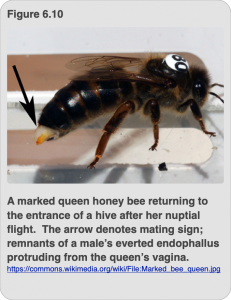
Remember Glenn Close in the movie Fatal Attraction? Yes, we know we are dating ourselves, but good stories never really grow old. Anyway, Glenn has kind of been the iconic scary female who was willing to kill anyone in her path, and even terrorize small children, to get the guy she wanted. Glenn was sort of an anomaly—rare enough that movie-watchers are willing to share in her fatal attraction, because they just can’t believe there are people like that. But among arthropods, the scary female figure is relatively common. You might say it’s even been institutionalized or normalized and just another way of getting things done. So, here’s one that comes close (pun intended) to being the arthropod version of Glenn—The Black Widow.
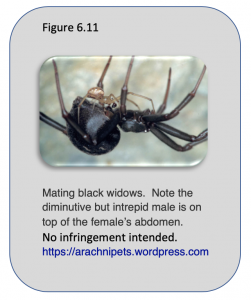
To begin with, the female is quite a bit larger than the male, which makes her a formidable character right off the bat. And like all other spiders, she’s a predator. That’s just how they roll. So when it comes time to reproduce, things get a little freaky. As you would assume, reproduction ensues with the very brave male mounting the female to deposit his sperm (Figure 6.11). And then the weird stuff happens. The female spider, as her nuptial gift to her intrepid partner, turns around and bites his head off. Literally. Off with his head! Once you recover from the brutality of it all, there is actually a biological reason for this. It seems that there is an inhibitory substance in the brain of the male that prevents him from releasing the sperm. So, in order to fertilize the eggs, the female nips off his head, the inhibition is overcome, the sperm are released, and her eggs get fertilized. And one male spider, minus his head, dies in the knowledge that his genes will be well represented in the next generation, and his body will help nourish his offspring.
Now to be fair, not all female black widows eat their mates all of the time. It might be overly estimated. However, it is a common enough practice that this is how the female earned her name, the Black Widow. Just as Hester Pyrnne was forced to wear a red letter “A” emblazoned on her ventral surface to acknowledge her sin in Nathaniel Hawthorne’s The Scarlet Letter, so too does the Black Widow bear the sign and seal of her transgression—a large red hour glass on her abdomen. She is marked forever as the one who consumes her mate, the one who should be avoided at all cost. And it is a message that we humans should take seriously too because the female black widow is one of two poisonous spiders in the State of Ohio. She will bite you if disturbed, and the venom in her bite can cause some pretty unpleasant physiological effects, even in locations distant from the bite. It is rarely fatal in humans—you’re pretty big, after all, and can dilute the poison in your blood. But if you see a black spider with a red hour glass on its abdomen, leave her alone, and be thankful that you’re not a male black widow.
Unique Methods of Producing Offspring
Now, at long last, it is time to compare and contrast the various ways in which humans and insects are capable of producing offspring. Although we are quite familiar with the processes by which humans produce and bring babies into this world, it is much less easy to talk about the norms in the way insects produce offspring. This is in large part because there are so many more insect species, allowing this group more opportunities to develop diverse ways of producing offspring. However, the variety and complexity of offspring production we see among insects is also one of the reasons this group is so fascinating and has been so evolutionarily and ecologically successful.
Human Reproduction, Sex Determination, and Delivery
Likely because human offspring only arise after the union of a male sperm cell and a female egg, traditionally, people have said that the ideal situation is for a mated pair to consist of one man and one woman. And while that may exist as an historical preference, human history has always entertained deviations from that norm, including serial monogamy, polygyny (several wives), and polyandry (several husbands). More recently, unions between same sex people have become accepted as a behavioral norm. And thanks to in vitro fertilization, same sex couples can even produce offspring by using donor sperm or egg cells.
Sex determination in humans is also very straightforward. You likely learned in your high school biology classes that among humans, females have two copies of the X chromosome, making them the homogametic sex (genotype of XX; produces the same gametes or egg cells that all have one X chromosome). In contrast, males have one copy of the X chromosome and one of the Y chromosome, making them the heterogametic sex (genotype of XY; capable of producing different gametes/ sperm cells that carry either the X or Y chromosome). Since all eggs carry the X chromosome, whether a developing embryo becomes a male or female depends on whether it was fertilized by an X or Y sperm. A final component of offspring production among humans is that we typically give birth to one child at a time, although multiple births are possible and, today, can be produced fairly easily with hormonal intervention.
Asexual Reproduction in Insects
It was big news when humans were able to successfully clone (produce an exact genetic copy of) the first mammal, Dolly the sheep, by implanting the nucleus of a female sheep into the egg of a donor sheep. Since then, we have been able to clone other mammals, including pigs and dogs, and perhaps in the future we might be able to clone humans as well. So, it might not surprise you to realize that there are literally hundreds of species of insects that have been cloning themselves for millennia.
The primary process by which insects clone themselves is called parthenogenesis. You know about this already if you studied Greek mythology, where you learned that the goddess Athena sprang fully formed from Zeus’ head. This is one way to do things with one parent. Insects can reproduce via parthenogenesis too, but the parent is inevitably female. The resulting offspring can be all female, in which case the process is called theletoky (theletokous adj.); all male, which is called arrhenotoky (arrhenotokous adj.); or a mixture of both, which is deuterotoky (deuterotokous, adj.).
Insect Sex Determination
Concerning the mechanisms responsible for sex determination in insects, many species do it the way humans do: both males and females are diploid (have two sets of chromosomes) and the sex is determined by what kind of sex chromosomes insects have. For most insect species, females again are the homogametic sex (XX) while males are heterogametic (XY). However, in some insects such as butterflies and moths, males are homogametic (ZZ) and produce sperm that only have the Z sex chromosome, while females are heterogametic (ZW) and produce some eggs that have the Z chromosome and others with the W chromosome.
Furthermore, some insects determine the sex of their offspring in a completely different way. By simply laying an unfertilized egg, a breeding female can produce a haploid type offspring—having only one set of genes that come from the mother and no contribution from the father. Among ants, bees, wasps, and thrips, these haploid individuals all become males. However, if the mother chooses to fertilize an egg using a male’s sperm, that offspring will become a female. This method of sex determination is called “haplo-diploidy.”
Delivery of Insect Babies
We noted previously that humans almost always give birth to only one child at a time. Obviously, things are much different among insects, although we will discuss the rare case of one mother one child among insects below. The more usual situation is that a single female will give produce hundreds or thousands of offspring. Most insects are oviparous, meaning that the female lays eggs which hatch outside of her body. The eggs then hatch and proceed through the life cycle discussed in Chapter 4. Indeed, many insects, such as cockroaches and praying mantids, package their eggs together in a structure known as an ootheca, or egg case (Figure 6.12). This offers some protection and nutrition to the eggs until they can hatch into nymphs, emerge from the ootheca, and become independent.
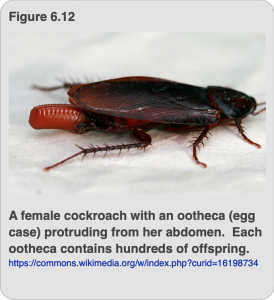
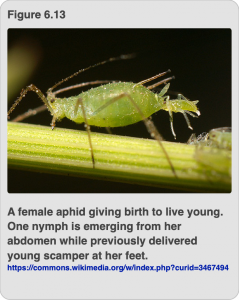
However, it is possible for insects to be ovoviviparous. In this case, that the eggs hatch while they are still inside the female’s abdomen, such that the first instar nymphs or larvae emerge directly from their mother (Figure 6.13). Obviously, this reduces the number of offspring that the female can generate in a single mating event. Yet this hasn’t negatively impacted the reproductive success of aphids, which in addition to being ovoviviparous can also be parthenogenic. These tiny insects, are serious pests on a number of plants that we like to grow. As aphids are hemimetabolous (remember Chapter 4), the nymphs pretty much look exactly like their mothers, except that they are smaller and lack a few features that will develop as the life cycle proceeds.
Females of the tsetse fly also incubate an egg that hatches inside of them, but they produce only one fertilized egg at a time. And, unlike aphids, the larva of the tsetse fly stays inside its mom for a very long time, and will even molt through all of its larval instars inside the mother. The whole time that mom is incubating her single baby, she nourishes her developing larva with a nutritive milk-like fluid. Interestingly, the milk gland that does all of this is found in the mother’s uterus. Indeed, many entomologists consider the tsetse fly to be an honorary mammal! The mother then proceeds to lay or “give birth” to an enormous single 4th instar larva that can weigh even more than she does (Figure 6.14 – click on link). After being expelled from its mother, the larva immediately buries itself underground where it pupates before emerging as an adult approximately one week later. Although female tsetse flies invest a tremendous amount of resources into reproducing only a handful of descendants (each female may only produce 10 offspring, and half of them will be male), nearly all of her offspring survive to adulthood. It’s like placing a single bet and hoping to win the jackpot, in contrast to typical insects that will produce hundreds or thousands of offspring in each reproductive cycle, but where very few of them survive. Clearly, insects have utilized lots of different approaches to reproduction!
Chapter Summary
In conclusion, just like us, insects have to find a mate, court their potential partner and copulate so that sperm and egg can be united, and the specific ways that insects and other arthropods find and seduce one another can be similar and different to the ways that we humans do it. Fertilization generally occurs internally in insects, just as it does in us, but most female insects can choose when to fertilize their eggs thanks in large part to their spermathecae or specialized sperm storage organs. We also learned that most insects are diploid and have 2 sets of chromosomes and lay eggs that hatch out later. However, there are interesting variations on this theme, such as aphids, walking sticks and wasps that can reproduce parthenogentically such that their offspring are clones of their mothers, and other insects, like aphids, flesh flies and tsetse, that can incubate the eggs inside of them until the live offspring emerge out of mom’s back-end. Given the diversity of insects and how very good most of them are at reproducing, it should be no wonder that we see so much variation in all elements of mate finding, courtship, copulation, fertilization and offspring production.
References
Chapter 6 Cover Photo: Mating beetles. CC0 Public Domain: cocoparisienne. Accessed via https://pixabay.com/en/ladybug-beetle-insect-nature-drip-248481/
Figure 6.1a: Male insect reproductive system. CC-BY-SA 3.0: Savita Murmure; Accessed via https://commons.wikimedia.org/wiki/File:Male_genitalia_Lepidoptera.jpg. Modified by M. Meuti.
Figure 6.1b: Male human reproductive system. Public Domain: US Federal Government/National Cancer Institute. Accessed via https://commons.wikimedia.org/wiki/File:Illu_repdt_male.jpg
Figure 6.2a: Species of firefly. Photo copyright: Terry A. Lynch. Accessed via http://10kfireflies.weebly.com
Figure 6.2b: Firefly flash patterns. Photo copyright: Terry A. Lynch.. Accessed via http://discoveringdarwin.blogspot.com/2015/12/chapter-ix-hybridism.html
See also: https://pbs.twimg.com/media/COAYqWdVEAEy_ez.png
Figure 6.3: Male dung beetle. CC BY-SA 2.0: Bernard DUPONT. Accessed via https://commons.wikimedia.org/wiki/File:Large_Copper_Dung_Beetle_(Kheper_nigroaeneus)_(13780464314).jpg
Figure 6.4: Katydid nuptial gift. CC-BY-SA 3.0: Gilles San Martin. Accessed via https://commons.wikimedia.org/wiki/File:20140713_122749_5249M.JPG
Figure 6.5: Scorpionfly nuptial gift. Author unknown. Available at http://nekhbet.com/ssel.shtml
Figure 6.6: Mating dance flies. CC-BY-SA 3.0: Onno Zweers. Accessed via https://commons.wikimedia.org/wiki/File:Mating_Empididae.JPG
Figure 6.7: Dragonflies mating in flight. Photo credit: József Szentpéteri. Available at http://ngm.nationalgeographic.com/2006/04/dragonfly-mating/ackerman-text
Figure 6.8: Dragonfly mating wheel. CC0 Public Domain: makamuki0. Accessed via https://pixabay.com/en/dragonflies-copulation-1702427/
Figure 6.9: Bed bug traumatic insemination. CC-BY-SA 1.0: Rickard Ignell, Swedish University of Agricultural Sciences. Accessed via https://commons.wikimedia.org/w/index.php?curid=6417662
Figure 6.10: Mated queen bee. CC-BY 4.0: Geoffrey R. Williams, Aline Troxler, Gina Retschnig, Kaspar Roth, Orlando Yañez, Dave Shutler, Peter Neumann, Laurent Gauthier (2015). “Neonicotinoid pesticides severely affect honey bee queens”. Scientific Reports 5: 14621. DOI:10.1038/srep14621. Available at https://commons.wikimedia.org/wiki/File:Marked_bee_queen.jpg
Figure 6.11: Mating black widows. Author unknown. Available at https://arachnipets.wordpress.com
Figure 6.12: Cockroach with ootheca. CC BY-SA 3.0: Toby Hudson. Accessed via https://commons.wikimedia.org/w/index.php?curid=16198734
Figure 6.13: Aphid giving birth. CC BY-SA 3.0: MedievalRich. Accessed via https://commons.wikimedia.org/w/index.php?curid=3467494
Figure 6.14: Tsetse fly giving birth. Photo credit: Ray Wilson. Accessed via http://www.raywilsonbirdphotography.co.uk/Galleries/Invertebrates/vectors/Tsetse_Fly.html
Figure 6.15a: Macromalthus debilis life cycle. Author unknown. Available at http://students.uta.edu/hl/hlb7922/micromalthus.html
Figure 6.15b: Macromalthus debilis. CC BY-SA 3.0: David R. Maddison. Accessed via https://commons.wikimedia.org/w/index.php?curid=20768620
Video 6.1: Dancing peacock spider. Video by Jurgen Otto. Accessed via https://www.youtube.com/watch?v=xYIUFEQeh3g
Video 6.2: Springtail mating ritual. From BBC’s Life in the Undergrowth. Accessed via https://www.youtube.com/watch?v=0Sq2gjsysG0
List 6.1. Contributions of Male Accessory Fluids to Reproduction. Information compiled by S. W. Fisher, from various sources.
Additional Readings
Judson, O., 2002. Dr. Tatiana’s sex advice to all creation: The definitive guide to the evolutionary biology of sex. Macmillan.
Kozlowski, M.W. and S. Aoxiang (2006). Behaviors associated with spermatophore transfer in Deuterosminthurus bicinctus (Collembola: Bourletiellidae). J. Ethology 24: 103-109.
Lehmann, G.U., 2012. Weighing costs and benefits of mating in bushcrickets (Insecta: Orthoptera: Tettigoniidae), with an emphasis on nuptial gifts, protandry and mate density. Frontiers in zoology, 9(1), p.1.
Shay, C. (2010). Top Ten Weird Insect Mating Rituals. Time Magazine, August 19.
Yoshizawa, K., Ferreira, R.L., Kamimura, Y. and Lienhard, C., 2014. Female penis, male vagina, and their correlated evolution in a cave insect. Current Biology, 24(9), pp.1006-1010.
Zhong, W., Ding, G. and Hua, B., 2015. The role of male’s anal horns in copulation of a scorpionfly. Journal of Zoology, 295(3), pp.170-177.